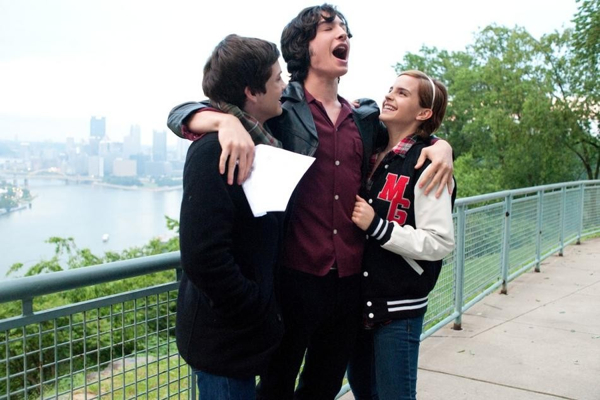Movie review by Greg Carlson
Heart-on-its-sleeve earnest and desperate to be both taken seriously and embraced by the young people who helped put more than a million copies of the novel in print, “The Perks of Being a Wallflower” aspires to the same kind of teen angst insider credibility owned by John Hughes in the 1980s. With David Bowie on the soundtrack and a cameo appearance by Joan Cusack, the movie pays Hughes respectful tribute during the course of its exploration of lunchroom caste systems, post-football game pot brownie parties, Rocky Horror performances, and heartfelt mixtape compilations.
Written and directed by “Wallflower” author Stephen Chbosky, the movie sticks close to the events described in troubled protagonist Charlie’s (Logan Lerman) letters to a “friend” in the book, dropping a subplot about an abortion and family scenes involving holidays spent with cousins. The author retains the core trio of thematic ballast: sexual abuse, the ugliness and consequences of homophobia, and (mostly) unrequited love. In “Slant,” Chris Cabin attacked the film as a “somewhat revolting piece of pop martyrdom, made for and isolated to the damaged middle class.” Cabin also detected “that certain, odious brand of liberalism that favors and tends toward victimization.” Given the movie’s milieu and ambitions, Cabin’s position may be a bit harsh.
The film remains virtually silent on the issue of class, but the characters clearly inhabit a world where attending college is a given (the movie version adds a thread of anxiety about Sam’s shaky application credentials). In the book, Charlie indicates that his family is not wealthy, and also that his grandfather is a racist, but the movie depicts the suburbs of Pittsburgh as a universe without much color. The same criticisms were often leveled at Hughes, causing one to wonder if teen films are somehow more glaring or noticeable in their homogeneity than romantic comedies, musicals, or thrillers.
As an epistolary novel, “The Perks of Being a Wallflower” relies solely on Charlie’s descriptions of his friends and the members of his family. Obviously, a film adaptation requires actors to inhabit the characters, and the casting choices – particularly the principal trio of Charlie, crush object Sam, and Sam’s step-sibling Patrick – prove one of the film’s greatest strengths. Both Ezra Miller and Emma Watson break free of their best-known roles – he as sullen, deeply damaged kids in “Afterschool” and “We Need to Talk About Kevin” and she as Hermione Granger in the “Harry Potter” juggernaut. Both supporting players leave a mark, and Miller especially runs off with every scene in which he appears.
Not all of Chbosky’s decisions carry water, however, and I for one find it hard to believe that bright, artistic-minded, popular culture-obsessed teenagers of 1991 would not recognize or be able to figure out how to identify Bowie’s “Heroes,” which is used as the “mystery tunnel song” in bookend scenes. And while the movie’s pre-Internet setting precludes the possibility of iTunes and Google searches, Charlie’s affinity for the Smiths’ “Asleep,” along with the soundtrack inclusion of New Order, Sonic Youth, XTC, the Cocteau Twins, and Galaxy 500, among others, paints a picture of sharp musical taste.
